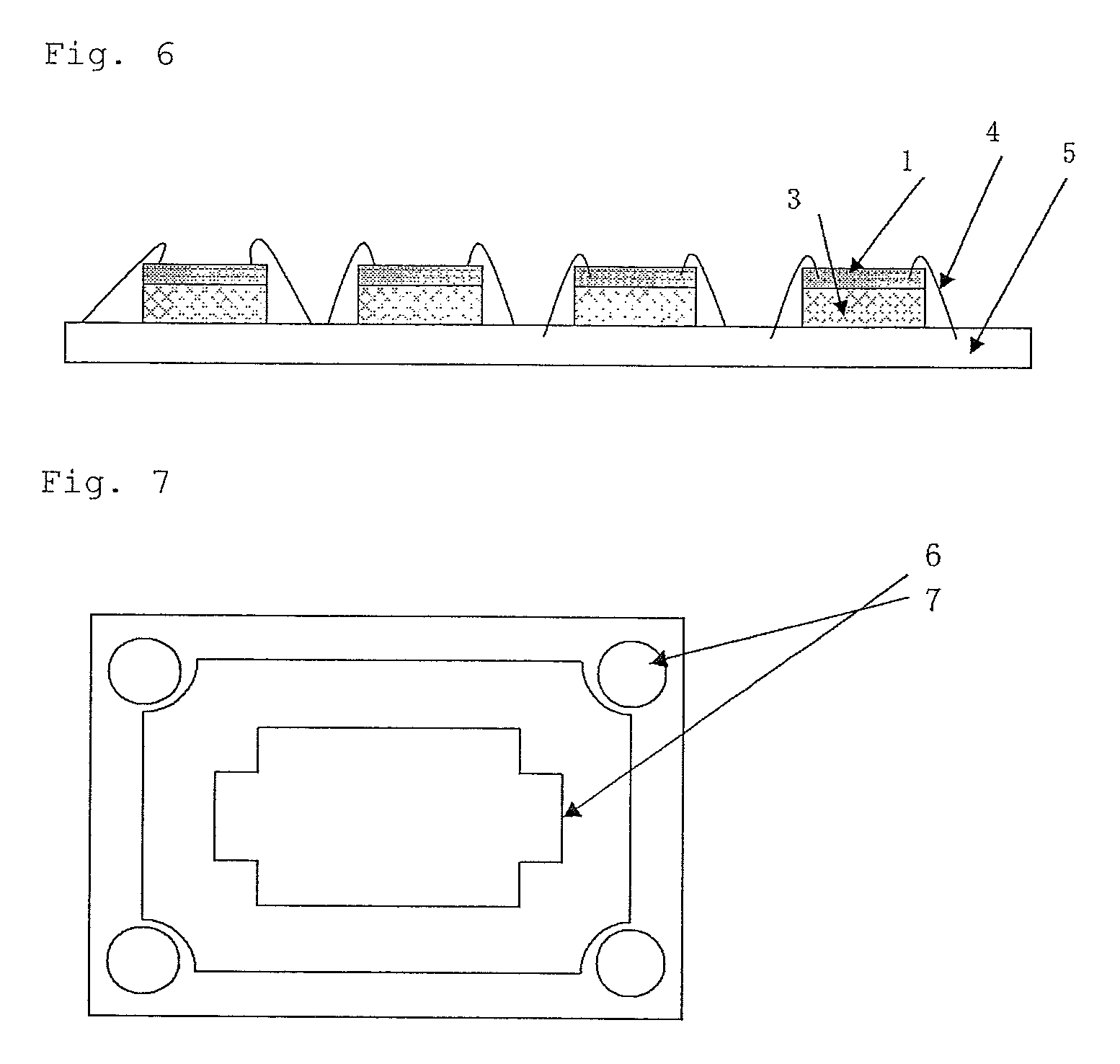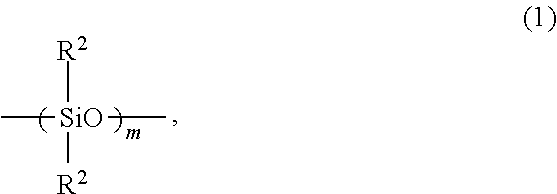Thermosetting silicone resin sheet and method for producing the same, and light-emitting apparatus using the thermosetting silicone resin sheet and method for producing the same
a technology of thermosetting silicone resin and thermosetting resin, which is applied in the direction of printing, layered products, other printing apparatus, etc., can solve the problems of complex production process, insufficient performance, and inability to laminate thermosetting silicone resin on an led device, etc., and achieves convenient sheet handling, favorable workability, and easy lamination
- Summary
- Abstract
- Description
- Claims
- Application Information
AI Technical Summary
Benefits of technology
Problems solved by technology
Method used
Image
Examples
synthetic example 1
Organopolysiloxane Resin Containing Vinyl Group (A1)
[0123]After organosilane represented by PhSiCl3 (27 mol) and ClMe2SiO(Me2SiO)33SiMe2Cl (1 mol) and MeViSiCl2 (3 mol) were dissolved into a toluene solvent, added dropwise into water, subjected to co-hydrolysis, washed with water and alkaline for neutralization and dehydrated, the solvent was stripped to synthesize a resin containing a vinyl group (Al). In the resin, the composition ratio of a constituent siloxane unit and the structure represented by [—SiMe2O-(Me2SiO)33—SiMe2O2 / 2] is represented by the formula: [PhSiO3 / 2]0.27[—SiMe2O-(Me2SiO)33—SiMe2O2 / 2]0.01[MeViSiO2 / 2]0.03. The weight average molecular weight of the resin was 62,000, and the boiling point was 60° C.
synthetic example 2
Organopolysiloxane Resin Containing Hydrosilyl Group (B1)
[0124]After organosilane represented by PhSiCl3 (27 mol) and ClMe2SiO(Me2SiO)33SiMe2Cl (1 mol) and MeHSiCl2 (3 mol) were dissolved into a toluene solvent, added dropwise into water, subjected to co-hydrolysis, washed with water and alkaline for neutralization and dehydrated, the solvent was stripped to synthesize a resin containing a hydrosilyl group (B1). In the resin, the composition ratio of a constituent siloxane unit and the structure represented by [—SiMe2O-(Me2SiO)33—SiMe2O2 / 2] is represented by the formula: [PhSiO3 / 2]0.27[—SiMe2O-(Me2SiO)33—SiMe2O2 / 2]0.01[MeHSiO2 / 2]0.03. The weight average molecular weight of the resin was 58,000, and the boiling point was 58° C.
synthetic example 3
Organopolysiloxane Resin Containing Vinyl Group (A2)
[0125]After organosilane represented by PhSiCl3 (27 mol) and ClMe2SiO(Me2SiO)33SiMe2Cl (1 mol) and Me2ViSiCl (3 mol) were dissolved into a toluene solvent, added dropwise into water, subjected to co-hydrolysis, washed with water and alkaline for neutralization and dehydrated, the solvent was stripped to synthesize a resin containing a vinyl group (A2). In the resin, the composition ratio of a constituent siloxane unit and the structure represented by [—SiMe2O-(Me2SiO)33—SiMe2O2 / 2] is represented by the formula: [PhSiO3 / 2]0.27[—SiMe2O-(Me2SiO)33—SiMe2O2 / 2]0.01[Me2ViSiO1 / 2]0.03. The weight average molecular weight of the resin was 63,000, and the boiling point was 63° C.
PUM
| Property | Measurement | Unit |
|---|---|---|
| thickness | aaaaa | aaaaa |
| particle diameter | aaaaa | aaaaa |
| molar ratio | aaaaa | aaaaa |
Abstract
Description
Claims
Application Information
 Login to View More
Login to View More - R&D
- Intellectual Property
- Life Sciences
- Materials
- Tech Scout
- Unparalleled Data Quality
- Higher Quality Content
- 60% Fewer Hallucinations
Browse by: Latest US Patents, China's latest patents, Technical Efficacy Thesaurus, Application Domain, Technology Topic, Popular Technical Reports.
© 2025 PatSnap. All rights reserved.Legal|Privacy policy|Modern Slavery Act Transparency Statement|Sitemap|About US| Contact US: help@patsnap.com



